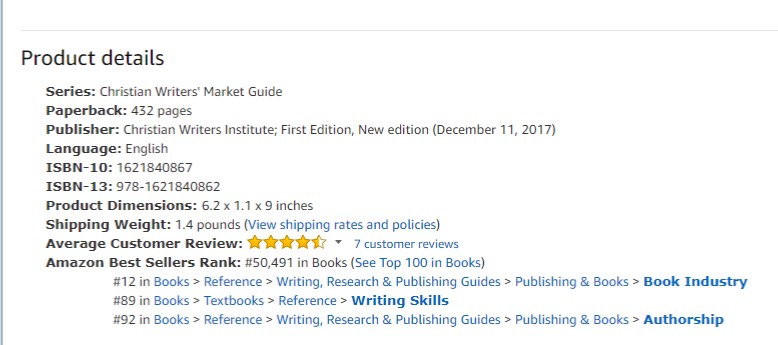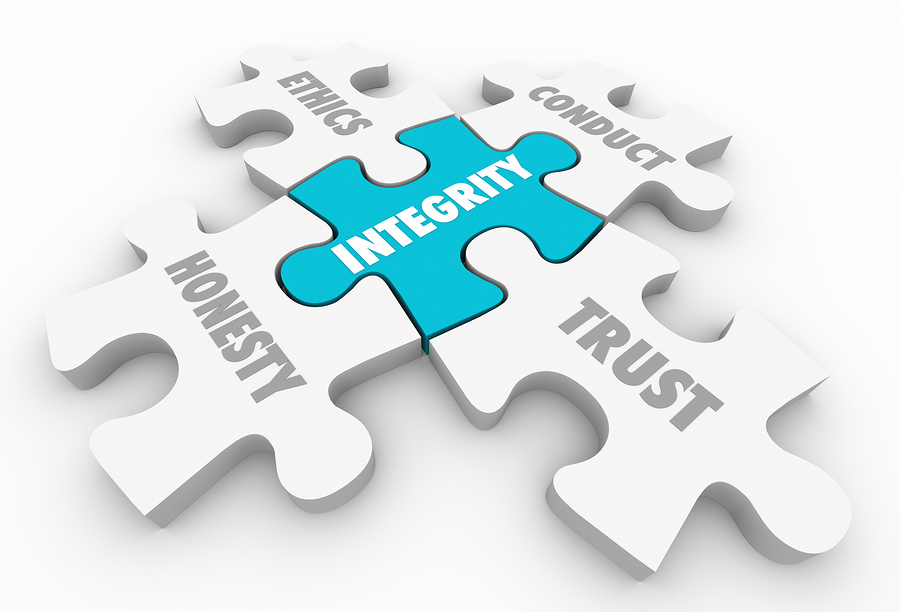Admit it. You’ve checked your Amazon.com sales ranking at least once since your book was published. You feel the need to have some outside confirmation of the sales of your book. And Amazon’s ranking are free to look at. It is one of the only public rankings available which adds to the need to look.
I’ve even seen book proposals where the author has gone to great lengths to include the Amazon ranking for each title that is competitive with the one the author is proposing. A prodigious amount of wasted effort.
I’ve known published authors who have gone into deep depression because their Amazon numbers aren’t very good. Others will mention that their rank jumped “by 10,000 this week!” suggesting they are tracking the numbers rather closely.
Consider for a moment how those rankings are calculated. Amazon is very secretive as to the exact formula (and some have gone to great lengths to figure it out) but consider looking at it as “the number of sales in a given period of time.” Much like the bestseller lists with USA Today and the New York Times, a book has to sell x number of copies to somehow “hit the list.”
TCK Publishing has created a site to help guess what the numbers mean. (Click here for the calculator.) In the screen shot example pictured at the top of this post (The Christian Writers Market Guide – 2018 Edition. Click on the picture to enlarge it.) the paperback (not ebook) sales rank of 50,491 equals 91 sales per month or 6 in one day. That is sort of close for the month of June, but I don’t think we sold six copies on Amazon yesterday…
I know of an author who thought that they could make the number jump by asking fans to wait until a specific day and have everyone buy the book from Amazon on that day. Over 100 fans participated. The result was a nice jump but it did not come close to cracking the top 100 sales ranking that day.
It is so fluid that it is hardly worth the obsession. Amazon is only one sales outlet out of hundreds. (Albeit it is a really big one.) It doesn’t reflect sales at the local grocery store, the airport, the independent retailer in your town, Barnes & Noble and other “big box” outlets like Walmart, Mardels, Costco, or even Hobby Lobby. In that light, consider Amazon as a single snapshot of a single moment from a single sales source.
In 2016 Brent Underwood wanted to see what it would take to become a #1 bestselling author on Amazon. He took a picture of his foot. He then converted that photo into a one page ebook with, you guessed it, a photo of his foot. He titled it Putting My Foot Down. He chose the two subject categories as “Transpersonal” under Psychology and “Freemasonry” under Social Sciences. Uploaded the ebook on Amazon. Then had three friends buy the book for 99 cents. Within hours he was a number one bestselling author. (Read the entire story here.)
The moral of that Brent Underwood story? Please avoid obsessing over your sales ranking!
To bring levity to the conversation, a husband and wife team created the following short video that is a hilarious send up on Amazon rank obsession. Make sure you watch past the credits:
[An earlier version of this article, now significantly revised and updated, was posted in January 2011.]






Somewhere between Amazon rankings and “an audience of one” is my happy medium.
Dear God, help me find it! Give me a balanced heart. Amen.
Love Brent Underwood story!!
I never look. To me, the important thing is that people are enjoying my books. That make them winners. Thank you for this article, Brent. I’ll share it with my writers and readers on my forum.
I’m fairly new at this…never considered the rankings so much as looking at the number of reviews. Is that something to consider? Thanks for keeping this light-hearted and the pressure off, Steve!
Well that was discomfiting. Using the Amazon Book Sales Calculator, I checked on a handful of my more popular books. While I can officially call myself a bestselling author — 600,000 copies sold — clearly I will not be retiring anytime soon on that trickle of royalties.
Back to the keyboard.
I followed Amazon rankings and blog stats until I realized that trends were changing how I wrote. The numbers got more important than the message.
What a great post. I love it that there are people out there who are as obsessive as I am. And that you’ve injected some good-humored common sense into the situation.
Let’s see — maybe there’s an app out there that will email me my Amazon sales ranking every day. 😉
Wow- this almost felt like Fun Fridays, what with the great Foot Down article (though I eagerly await Putting Your right Foot Forward) and the video…thanks so much!
How funny!
I wasn’t thrilled with Amazon. Ever. I wrote a cookbook (S/P) a long time ago and ordered them POD, because Amazon took out a zillion bucks and I had to reach $100 in sales (not their cut) to get a royalty check. I used to work with people and nutrition.
So, I charged what was set on Amazon. I saved the buyer money on shipping. I removed any reading material from the rooms, save my book. Gave them a good fifteen minutes to read a few recipes…
Worked great. However, people forget to review, but I didn’t care much. Then, a friend of mine (an author) told me Amazon removed over 50 of his reviews. I finally checked mine. Sure enough, the reviews I had (which were not too shabby) had reduced to FOUR.
Pfft. I left Amazon books. I prefer my local bookstore. I can keep a wish list on Amazon and then order them. I am not an ebook reader. What does that do for the author? Sometimes ebooks are not counted in that number of sales.
As long as I buy anything else from Amazon for $50 bucks a year, I can review a book. Which I do.
Now that my cook book is way out of date, I don’t bother.
I’ve heard little about Amazon rankings, and I’ll certainly keep this blog post in mind should publishing time comes for me. I’d think there’d be a lot of other things to really be mindful of than watching Amazon rankings like a hawk. 🙂
This was so much fun! I agree that it was like Fun Friday material, but it gave a reality check too. Thank you!
Sorry I missed this conversation in real time, but I was in a pickup driving cross-country in Utah. I’m indie with >90% of my sales through Amazon and >97% of my international sales as Kindle e-books, so I do monitor real-time sales through KDP (Amazon’s e-book and now also paperback publishing arm). The scientist in me LOVES data of any sort, and Amazon provides lots, both domestic US and international sales, but it can be hard to interpret.
I don’t know about KDP paperback sales because I still publish mine through CreateSpace and Ingram Sparks. I can provide some info on KDP ebook and CreateSpace paperbacks and their Amazon ranking that might be of interest.
First some ebook comments. An e-book sale appears in the KDP sales dashboard almost instantly. However, there is a time delay between when a sale of an e-book occurs and when it registers in the sales rank at the Amazon website. The sales ranks update hourly, but a sale might not appear at the next hourly update. Sometimes it seems to be several hours, and an international sale is more likely to be delayed. At best as I can tell, all the e-book sales ultimately register in the e-book sales ranks. The rankings are also a time-average over, I believe, 30 days. A book that sells steadily at a good rate will rank better than one that has a huge spike in sales and then few or none. That means continual marketing over the long haul is probably more beneficial than pouring all your effort into getting high numbers at launch but not following up with activities to keep sales active after that pulse.
Selling 10 e-books a day will keep a title consistently in the top 100 for Christian historical fiction or romance. It will probably even get you into the top 50 most days. Seven books a day is usually enough to crack the top 100 in those categories.
However, many of the paperback sales through CreateSpace do NOT show up in the sales rank for the paperback…ever. Some do, many don’t, and I have yet to figure out what makes a sale not show up. A single counted book sale will pop your paperback up into the 100K-200K range in paperback ranking. When the Amazon algorithm decides not to count the paperback sales, it’s a steady drift down into the 2-millions over the course of a month. The problem of not counting CreateSpace paperback sales appears to have worsened since KDP started printing paperbacks. I’d like know if all the KDP paperbacks get counted.
A comment on organic reviews: I have read that the natural rate of readers submitting reviews when you haven’t deliberately solicited them with advance reader copies is about 1 per 100 sales. I haven’t tried to get lots of advance reviews because they often don’t feel like they reflect the spontaneous enthusiasm of a reader who reviews after buying the book. I’ve relied on readers who love my novels putting in the effort to submit a review. Maybe that’s not the wisest approach, and I should rethink it. But I only read the content of a few reviews when I’m shopping. I’m more influenced by a few heartfelt reviews triggered by genuine love a book than by total numbers.
Everytime you click on any Amazon webpage, the enterprise gets paid. This is just another scheme to make money, in this case, using the desperation of authors who, having worked so hard, want to see any smidgeon of progress in sales to the point of creating an obsession, which I liken to the sensation one gets from gambling. Depressed when you lose money or the graphline is as flaccid as a sleeping elephants trunk to elated to get the money or the graph line gets an erection. I’m beginning to think the rank system is a lure to generate more profits for the machine i.e. the monster Amazon so now I will go into therapy and quit clicking.